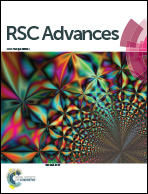Nanoscale architecture of bimetallic hybrid Fe–Au nanostructures with and without 1,4-phenylene diisocyanide pre-functionalization†
Abstract
The nanoscale architecture of a hybrid material has been very important in deriving a new interesting synergic property. Here, we have demonstrated that the functionalization of Au by 1,4-phenylene diisocyanide (PDI) provides a new platform of fabricating smart hybrid materials by electrochemistry. Iron nanorice particles (Fe NrPs) have been electrochemically hybridized with bare and PDI-functionalized Au nanoisland (NI) templates. Their interfacial electronic structures and morphologies have been studied and compared with those of Au sputter- or electro-deposited on Fe NrPs without PDI pre-functionalization. The electrochemically prepared Fe NrP is found to consist of an Fe–FeO core–shell structure covered by thin Fe2O3 and/or FeOOH by using depth-profiling X-ray photoelectron spectroscopy (XPS). Remarkably, bare Au NIs supported on Si become aggregated to form bigger islands upon applying a potential. PDI functionalization of Au prevents such a potential-induced aggregation, thereby facilitating Fe NrPs to be deposited on top of the Au NI templates without translocating the Au NIs. No notable difference in the XPS features between Fe on Au with and without PDI-functionalization are found, with no evidence of interfacial Au–Fe alloy formation. For Au on Fe NrPs, the Au 4f XPS peak is shifted to a higher binding energy position with sputtering depth, suggesting the formation of cationic Au–O chemical bonding species at the interface.


 Please wait while we load your content...
Please wait while we load your content...